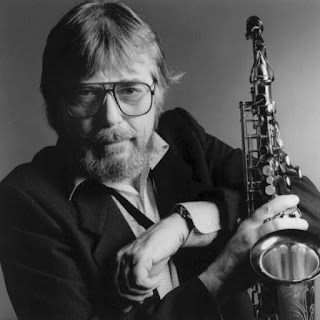Bud Shank (May 27, 1926 – April 2, 2009) was an American alto saxophonist and flautist. He rose to prominence in the early 1950s playing lead alto and flute in Stan Kenton's Innovations in Modern Music Orchestra and throughout the decade worked in various small jazz combos. He spent the 1960s as a first-call studio musician in Hollywood. In the 1970s and 1980s, he performed regularly with the L. A. Four.
Shank ultimately abandoned the flute to focus exclusively on playing jazz on the alto saxophone. He also recorded on tenor and baritone sax. His most famous recording is probably the version of "Harlem Nocturne" used as the theme song in Mickey Spillane's Mike Hammer. He is also well known for the alto flute solo on the song "California Dreamin'" recorded by The Mamas & the Papas in 1965.
Clifford Everett "Bud" Shank Jr. was born in Dayton, Ohio, United States. He began with clarinet in Vandalia, Ohio, but had switched to saxophone before attending the University of North Carolina. While at UNC, Shank was initiated into the Pi Kappa Alpha fraternity. In 1946, he worked with Charlie Barnet before moving on to Kenton and the West coast jazz scene.
He also had a strong interest in what might now be termed world music, playing Brazilian-influenced jazz with Laurindo Almeida in 1953 and 1954. Shank also joined the Lighthouse All-Stars in August 1953 and stayed with them until early January 1956. In 1958, he is the first American jazz musician to record in Italy, with an Italian jazz orchestra conducted by Ezio Leoni (aka Len Mercer).
His world music collaborations continued in 1962, fusing jazz with Indian traditions in collaboration with Indian composer and sitar player Ravi Shankar. Shank ensconced himself in the L.A. studios during the '60s, emerging occasionally to record jazz and bossa nova albums with the likes of Chet Baker and Sergio Mendes. Shank's 1966 album with Baker, Michelle, was something of a popular success, reaching number 56 on the charts. Film scores on which Shank can be heard include The Thomas Crown Affair and The Barefoot Adventure.
In 1974, Shank joined with Ray Brown, Shelly Manne (replaced by Jeff Hamilton after 1977), and Laurindo Almeida to form the group the L.A. Four, who recorded and toured extensively through 1982. Shank helped to popularize both Latin-flavored and chamber jazz music, and as a musician's musician also performed with orchestras as diverse as the Royal Philharmonic, the New American Orchestra, the Gerald Wilson Big Band, Stan Kenton's Neophonic Orchestra, and Duke Ellington. Shank had been one of the earliest jazz flutists, but in the mid-'80s he dropped the instrument in order to concentrate on alto full-time.
During the last two decades of the 20th century, he recorded small-group albums at a modestly steady pace for the Contemporary, Concord, and Candid labels. Shank's 1997 Milestone album, By Request: Bud Shank Meets the Rhythm Section, presented the altoist in top form, burning down the house with a band of relative youngsters who included neo-bopper pianist Cyrus Chestnut. Three years later, Silver Storm was released.
Shank continued performing and recording after the turn of the millennium, undertaking the challenging task of forming the Los Angeles-based Bud Shank Big Band in 2005 and making his recording debut as a big-band leader with Taking the Long Way Home, released the following year by the Jazzed Media label. In 2007 Jazzed Media issued Beyond the Red Door, a duet recording by Shank and pianist Bill Mays. A documentary film about Bud Shank, Bud Shank "Against the Tide" Portrait of a Jazz Legend, was produced and directed by Graham Carter of Jazzed Media and released by Jazzed Media as a DVD (with a companion CD) in 2008. The film has been awarded four indie film awards including an Aurora Awards Gold.
His last gig in the Los Angeles area was at the Jazz Bakery in January 2009. Shank's passion for jazz remained strong to the very last days of his life; he died at his home in Tucson, AZ on April 2, 2009 of a pulmonary embolism shortly after returning from a recording session in San Diego. Shank's doctors had reportedly warned the saxophonist -- who had moved to Tucson for health reasons -- that playing the session could be life-threatening. Bud Shank was 82 years old.
(Edited from Wikipedia & AllMusic)







